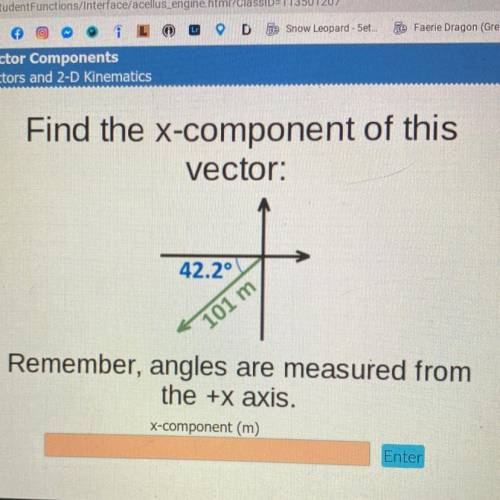Find the x-component and y of this vector
...

Answers: 2


Another question on Physics

Physics, 21.06.2019 14:50
Ingrid wrote the hypothesis below. if the temperature of a liquid increases, the density of the liquid decreases because the particles move farther apart. what are the variables in her hypothesis?
Answers: 3

Physics, 21.06.2019 17:20
American eels (anguilla rostrata) are freshwater fish with long, slender bodies that we can treat as uniform cylinders 1.0 m long and 10 cm in diameter. an eel compensates for its small jaw and teeth by holding onto prey with its mouth and then rapidly spinning its body around its long axis to tear off a piece of flesh. eels have been recorded to spin at up to 14 revolutions per second when feeding in this way. although this feeding method is costly in terms of energy, it allows the eel to feed on larger prey than it otherwise could. 1.a field researcher uses the slow-motion feature on her phones camera to shoot a video of an eel spinning at its maximum rate. the camera records at 120 frames per second. through what angle does the eel rotate from one frame to the next? 2. the eel is observed to spin at 14 spins per second clockwise, and 10 seconds later it is observed to spin at 8 spins per second counterclockwise. what is the magnitude of the eels average angular acceleration during this time? 3. the eel has a certain amount of rotational kinetic energy when spinning at 14 spins per second. if it swam in a straight line instead, about how fast would the eel have to swim to have the same amount of kinetic energy as when it is spinning? 4.a new species of eel is found to have the same mass but one-quarter the length and twice the diameter of the american eel. how does its moment of inertia for spinning around its long axis compare to that of the american eel?
Answers: 1

Physics, 22.06.2019 05:20
A3.9 g aluminum foil ball with a charge of +4.1×10−9 c is suspended on a string in a uniform horizontal e⃗ field. the string deviates to the right and makes an angle of 30∘ with the vertical. part a part complete what information about the e⃗ field can you determine for this situation? what information about the field can you determine for this situation? only the magnitude of e⃗ only the direction of e⃗ both the magnitude and the direction of e⃗ none of the above previous answers correct part b determine the magnitude of the electric field. express your answer with the appropriate units. e e = nothing nothing request answer part c determine the direction of the electric field. determine the direction of the electric field. to the right to the left away from you toward you
Answers: 3

Physics, 22.06.2019 09:00
Chemical energy is a form of energy. a. heat b. kinetic c. potential d. electromagnetic
Answers: 2
You know the right answer?
Questions

Mathematics, 27.08.2019 13:30


Mathematics, 27.08.2019 13:30






Computers and Technology, 27.08.2019 13:30

Mathematics, 27.08.2019 13:30

Computers and Technology, 27.08.2019 13:30



World Languages, 27.08.2019 13:30



Computers and Technology, 27.08.2019 13:30



Mathematics, 27.08.2019 13:30




